Analyzing the Price of Mobility: Desktops vs. Laptops
by Jarred Walton on September 7, 2013 5:55 PM ESTGPU/Graphics Performance Discussion
The other area of performance we want to look at is the GPU/graphics side of the equation. Where CPU performance has really started to level off – only overclocked CPUs or hex-core/octal-core options really hold serious performance advantages over the fastest mobile CPUs, and then only in heavily threaded workloads – the same can’t be said of graphics chips. Part of the problem is power requirements, as high-end desktop GPUs can draw up to 300W under load, which is three times what the most powerful mobile GPUs are rated to draw. The form factor also comes into play, but really I think power is the far more limiting factor.
Of course, there's a big difference in terms of what we do with CPUs vs. GPUs and how we do it. Most CPU-intensive tasks don't easily scale beyond a certain level of multi-threadedness, and some tasks really don't scale at all. The easiest example is anything that requires user input: no matter how fast your CPU gets, Word isn't going to type any faster than your fingers can go – or if you use speech recognition, any faster than you can dictate. Graphics on the other hand is practically infinitely parallel, where we can break things down into smaller and smaller pieces of a screen being rendered/computed by individual GPU cores. Many tasks on the CPU don't scale beyond four or maybe eight cores, but graphics is easy to scale to thousands of cores and beyond. So GPUs can get as large/fast as we can conceivably make them and there are still ways to tap into that performance potential; that's why modern systems typically have GPUs that consume two to ten times as much power as the CPU(s).
Let’s again put together some comparisons, only this time we’re a bit more limited in what we’ve tested with modern GPUs – on our desktop tests, we only have an overclocked GTX 680 and a GTX 780 with all of our gaming results, while on mobile we have a few additional reference points. I’ve also added Bioshock Infinite and Sleeping Dogs numbers for additional GPUs from our GPU 2013 test suite, but that’s only two of the seven titles we’re testing on laptops. We’re now looking at entire systems, but the GPUs are the primary factor in gaming performance. Also note that our reference point (1080p Max Detail, usually with anti-aliasing) is far more demanding than what most gamers actually require, but in terms of a performance discussion at least we can get an idea of where mobile GPUs stand.
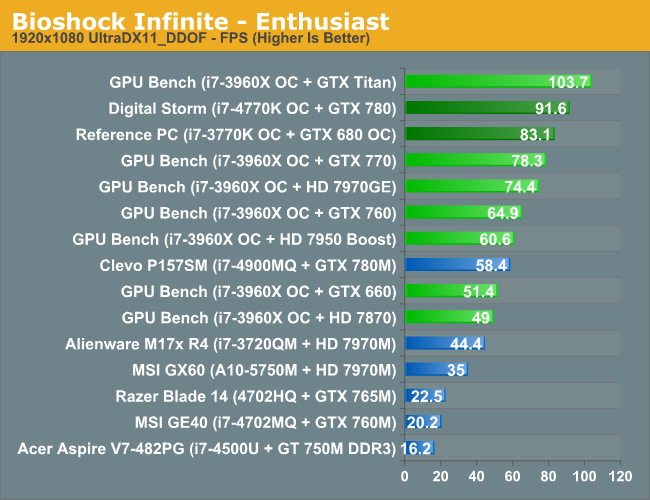
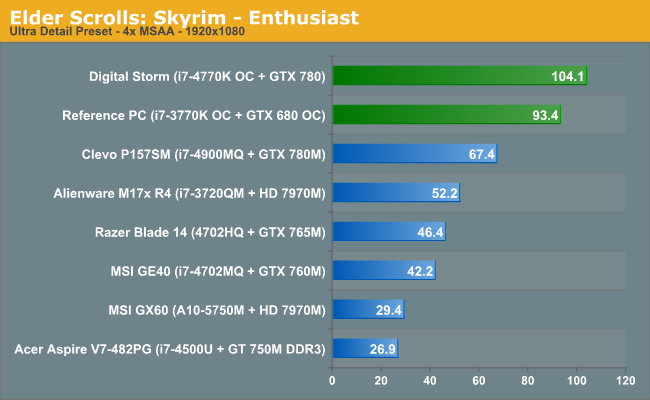
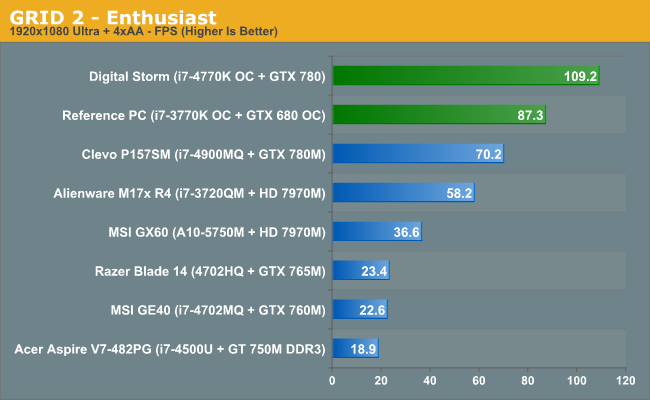


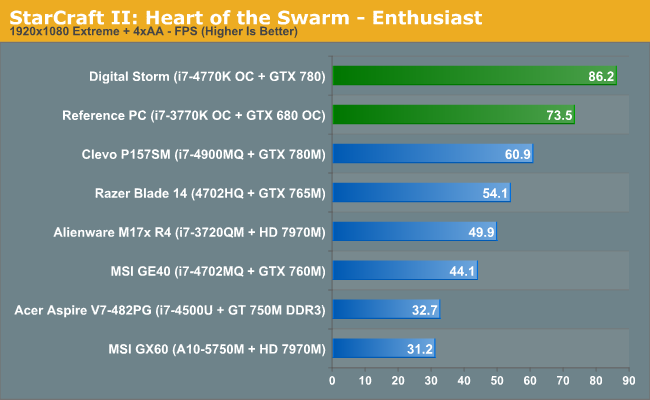
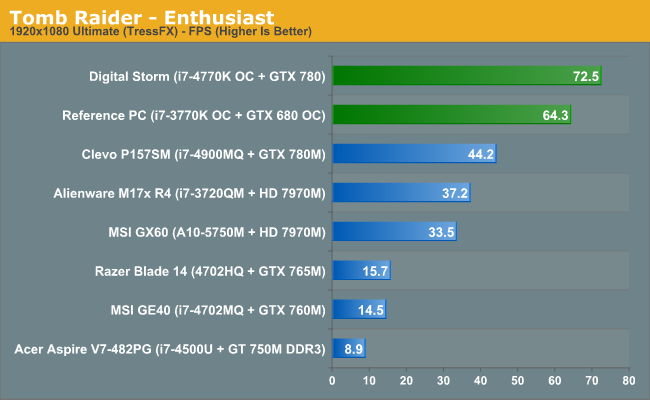
As far as replacing gaming desktop performance with a notebook is concerned, we’re nowhere near close to accomplishing this task. CPU requirements for the vast majority of users have reached a plateau during the past five or so years, but for graphics (games) we can still use pretty much all the horsepower available. The fastest mobile GPU we have right now, the GeForce GTX 780M, ends up delivering performance that falls roughly half way between the GTX 660 and GTX 760, or if we look at the Digital Storm system Dustin tested, it offers 60-70% of the performance of that desktop. Moving down to the lower performance mobile GTX parts like the GTX 765M, we haven’t tested any desktop GPUs in recent history that are anywhere near that slow – even the GTX 660 tends to be more than twice as fast as the GTX 765M and the GTX 560 Ti is still 50% faster. Drop one level further to the GT 750M (DDR3) and performance is about 60-80% of the GTX 765M! It’s not that you can’t game on a GT 750M or GTX 765M, but you’ll definitely need to drop the details down from max and turn off anti-aliasing. Finally, no matter what you do with a notebook, you’re not going to match the performance of the fastest desktop GPUs – the GTX Titan nearly doubles the performance of the GTX 780M, and even SLI GTX 780M isn’t likely to beat a Titan on a consistent basis.
Looking at pricing is also illuminating. Most notebook vendors charge around $650 (give or take) for a second GeForce 780M on the Clevo P370SM, compared to the desktop GTX 760 (which has slightly higher performance) that can be purchased for $250. Meanwhile, the desktop GTX 780M sells for the same $650 price as the GTX 780 while offering only 60-70% of the performance you get from the desktop GPU; the GTX 680 and GTX 770 have the same number of CUDA cores (1536) and go for $400, delivering superior performance at a substantially lower cost. The pattern continues as we move down the product stack; the slowest desktop Kepler, the GeForce GT 630, is a $65 card that has slightly higher clocks than the GT 750M, never mind the GT 730M and GT 740M, but the GT 730M is typically a $70 upgrade on a notebook. The GTX 765M has the same number of cores as the $130 GTX 650 Ti but with lower clocks; it reputedly sells for close to the same price to laptop OEMs as the desktop GTX 760 we mentioned as a performance equivalent of the GTX 780M.
Of course, where you can easily add a GPU to most desktops, with laptops you’re basically stuck with whatever you initially purchase. I noted in the Gaming Laptop Guide last month that the lowest price I could find for a notebook with a GTX 780M ends up around $1750 (including the OS with a 1TB HDD). For equivalent performance (more or less), we can take the desktop we listed above and add a GTX 760 GPU, with a slight PSU upgrade as well just to be safe. Here’s what we end up with:
| Mainstream Gaming Desktop PC | ||
| Component | Description | Price |
| CPU | Intel Core i5-4670 (Quad-core, 3.4-3.8GHz, 6MB L3, 22nm, 84W) | $200 |
| Motherboard | ASRock Z87 Pro3 LGA-1150 | $115 |
| GPU | GeForce GTX 760 | $250 |
| Memory | 2x4GB DDR3-1600 CL9 1.5V RAM | $65 |
| Storage | Seagate 1TB 7200RPM HDD | $70 |
| Optical Drive | SATA DVDRW (Lite-On) | $18 |
| Case | Antec Three Hundred | $60 |
| Power Supply | Rosewill Green RG530-S12 530W 80 Plus Bronze | $55 |
| Operating System | Windows 8 64-bit (OEM) | $100 |
| Total | $933 | |
Opting for a gaming notebook thus carries a hefty price premium, nearly doubling the price of a similar performance desktop. Yes, the notebook still gives you a battery, display, keyboard, touchpad, and speakers as part of the package, but if you already have those for an existing desktop they’re not really necessary. The price premium for high-end gaming notebooks has certainly come down from the 2x-3x we used to see (though you can still get to that range with SLI notebooks), but we’re nowhere near parity like we are on the CPU side of things. As an alternative, desktop GPUs are also able to hit much higher performance levels at a similar cost to a high-end gaming notebook.
Given the various options, many people have concluded that it’s far better to have a decent gaming desktop like the one above and then to spend another $500-$1000 on a good laptop for when you need to go mobile. That’s generally my recommendation as well – for all the gaming notebooks I’ve reviewed over the years, I still turn to my desktop system 95% of the time when I’m looking to play a game. On the other hand, not everyone wants to worry about having two computers and syncing data between them, and there are also space limitations to consider. Finding a spot for a 10 pound gaming notebook in a college dorm is easy enough; finding space for a gaming desktop with display, speakers, keyboard, and mouse can be a bit more difficult. And if you’re regularly on the road and want to take your games with you, you’ll need the laptop regardless.
There’s no right answer for how to do things, of course. Some people love gaming notebooks and others don’t see the point. But while you can certainly make a case for typical notebooks/laptops now being close to price parity with similar performance desktops, once you add gaming into the mix you’ll need to pay the mobility piper his due.










110 Comments
View All Comments
JarredWalton - Saturday, September 7, 2013 - link
Yeah, apparently anything tagged AMD gets the branding. Ah well... not my problem! Hahahateiglin - Saturday, September 7, 2013 - link
I might be torpedoing this workaround by mentioning it, but the print view uses the standard color scheme (and is way better in all other ways as well).b3nzint - Saturday, September 7, 2013 - link
"it’s far better to have a decent gaming desktop and then to spend another $500-$1000 on a good laptop for when you need to go mobile"yes right.
pc / laptop, its like comparing boys or girls. they r on diff "world". case closed.
Roland00Address - Saturday, September 7, 2013 - link
CPU performance does not scale well with power consumption. Architectures are design to hit a desired cpu clock speed and anything above that desired clock speed causes a massive increase of power consumption. The 2nd and 3rd generation core series have massive increase in power consumption to get higher performance at 3 ghz and massively increase in power consumption past 3.5 ghz. I am assuming this holds true to haswell as well. (This is probably why intel keeps the laptop cpu range in <3 ghz range using boost to go past 3.0 and the same logic with desktop cpus of 3.5 ghz using boost to get 3.5 ghz.)There is a great anandtech forum post i7-3770K vs. i7-2600K: Temperature, Voltage, GHz and Power-Consumption Analysis by Idontcare that demostrates this very nicely in graph format.
You can't scale cpu usage very well by being more parallel for most software can't be made parallel past 4 cores very well (video rendering being an exception.) Thus the only way to increase cpu performance is better architecture with more transistors, or higher clock speed.
Because of this you can get very similar cpu performance in laptops vs desktops.
--------
Graphics on the other hand scales very well increased parallelization. The only limiting factors with graphics is the cost of the silicon, and the thermal constraints. Thus you will always get massively better gpu performance in desktop vs laptops for you are not limited by thermal constraints. It is okay to run that gpu with a desktop at 300 watts while the desired power consumption for a laptop card is either less than 50 watts or 50 to 100 watts for a desktop replacement.
This will probably never change with time.
nerd1 - Saturday, September 7, 2013 - link
The whole point here is that nowadays most games run just fine with 50W GPU at 1080p with pretty much everything turned on, as they are supposed to run on 8-year-old consoles as well. So for most people mainstream laptops are approaching the point that they are 'good enough' for gaming.Roland00Address - Saturday, September 7, 2013 - link
Well that was not communicated very well then considering the choices made for testing (hint almost all of then are in desktop replacement where the gpu by itself takes more than 50W of energy)750m is about 38 W tdp
760m is about 55 W tdp
765m is about 75 W tdp
770m is about 75 W tdp
780m is about 122 W tdp
Of the games tested the 765m is only above 30 fps in starcraft ii and skyrim (at 1080p) all the other games we need to turn down the settings to get above 30 fps. If you chosen instead a gtx 760 ($250 dollar desktop card) you can get those same games at 60fps in all the games except metro 2033. Tomb Raider would be close for it would be in the mid 50 fps.
You can get an enjoyable "ultimate" performance out of a laptop if you go full desktop replacement such as a alienware 17", clevo, msi, asus rog, etc but as the chart shows you would get much better gpu performance out of a desktop. Remember these laptops would be a desktop replacement and thus weigh over 7 lbs and have a gpu that is using 75+ watt tdp.
You can get "great" performance out of a geforce 760m or 765m but it won't be "ultimate" either the resolution has to go down or the settings (medium or high instead of ultra) has to go down to get current games at a 30+ fps.
--------------------
In a few years (a die shrink, maybe two) you can get a future gpu to run at 50w and do all these current games on 1080p with these settings at 60fps. Then again during that same time we will get xbox 360 and ps4 console ports for any new game thus you will be needing once again a desktop replacement to get similar performance to the console. You will not be getting a ps4 gaming performance in your ultrabook in the next 3 years. In your larger laptops it will be another matter.
--------------------
So I repeat my larger point, you can get similar cpu performance easily in a laptop. You can't get similar gpu performance in a laptop vs desktop for with a desktop you are not limited by thermals while with laptops you are trying to keep total thermals (cpu+gpu+screen+everything else) under 65w for normal laptops/ultrabooks, about 100w for things like the razer blade 14" / 15" retina display, 125w to 150w for beginner desktop replacements such as the gtx765m (msi dragon 17") and 200w for alienware 17" with a single gtx780m.
nerd1 - Saturday, September 7, 2013 - link
There is no ceiling for *ultimate* performance, you can spend $3K for tri-titan setup, add liquid cooling to OC them, another a few K for (multiple) 4K displays and so on. 60fps may not be enough for some *ultimate* gamers. I've been playing fps myself for years, and old quake 2 required 100+fps framerate for some techniques (like acceleration jump)What we're discussing now is *good enough* performance, which I can be achieved by 760M or 765M. 765M is reasonably cheap, can be fit into either 13 inch laptop or 18mm thin laptop, and can run most game. I've been using similarly powerful 6990M GPU for a while.
MDX - Sunday, September 8, 2013 - link
Well saidSaint04 - Saturday, September 7, 2013 - link
To the author,I just wanted to say that I had noticed the comment under the Alienware 17 review about the need for contrasting mobile GPUs from Desktop GPUs. You did just that and in a timely fashion too! I just wanted to say thank you for being responsive to your readers.
jjj - Saturday, September 7, 2013 - link
Ok so no OC in CPU perf,you include a 250$ GPU just to push the price way up and you fully miss the real issue.The question you have to ask is why? Why are we here?
We pay 300$ for a small die and a large part of it is a GPU we don't use or need.
We can't touch a 6 core CPU at 250mm2 ,it costs too much. not so long ago Intel would have had to sell it at 300$ ,hell they would most likely have 8 core dies with less cache if there was any damn competition.
Things are not getting better in laptop ,they are just getting much much worse in desktop.and greed is killing the only PC segment that can be exciting. For short term gains Intel is killing the long term.
And even in laptop they are pushing ultrabooks to try to reset performance to a lower level and shorten the refresh cycle while pushing prices up.
All they'll achieve with this is speed up the transition away from Wintel and allow ARM to catch up in perf faster. They couldn't do worse than this if they would hire Elop as CEO.
Why don't you compare die size (excluding GPU) and price over the last decade in desktop instead of doing this article.